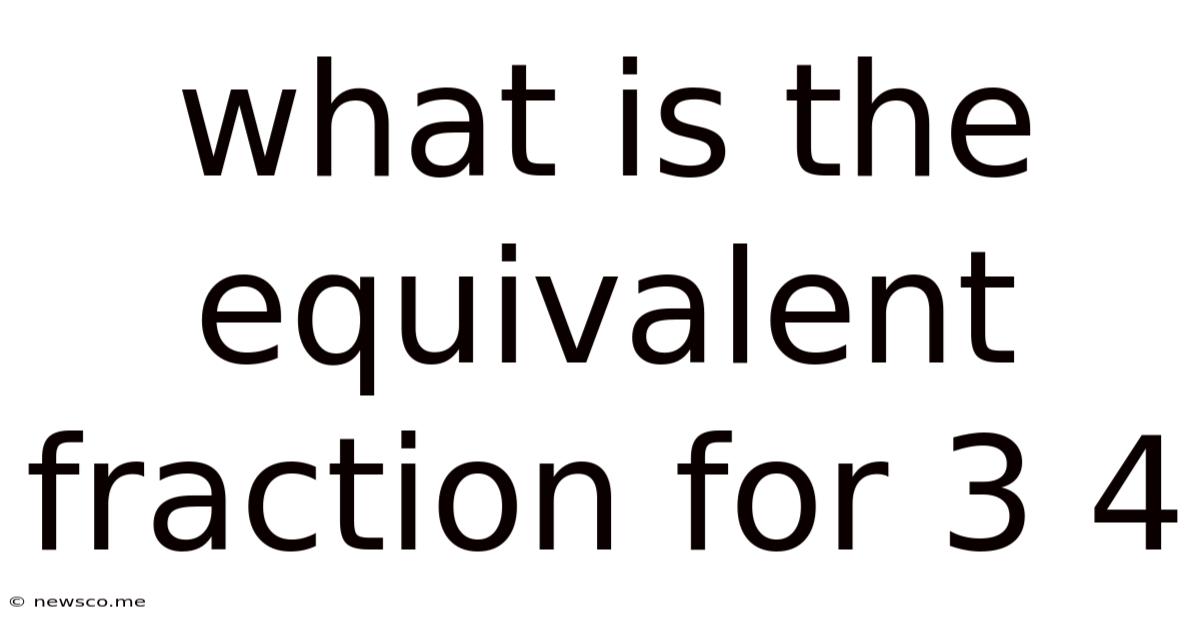What Is The Equivalent Fraction For 3 4
News Co
Apr 17, 2025 · 5 min read

Table of Contents
What is the Equivalent Fraction for 3/4? A Deep Dive into Fractions and Equivalence
Understanding fractions is fundamental to mathematics, and mastering the concept of equivalent fractions is crucial for success in various mathematical operations. This comprehensive guide explores the meaning of equivalent fractions, explains how to find equivalent fractions for 3/4, and provides numerous examples to solidify your understanding. We'll also delve into the practical applications of this knowledge and address common misconceptions.
What are Equivalent Fractions?
Equivalent fractions represent the same proportion or value, even though they appear different. Imagine slicing a pizza: if you cut it into four slices and take three, you've eaten ¾ of the pizza. Now imagine you cut the same pizza into eight slices. To eat the same amount, you would need to take six slices (6/8). Both ¾ and 6/8 represent the same portion of the pizza – they are equivalent fractions.
The key principle behind equivalent fractions lies in the concept of multiplying or dividing both the numerator (top number) and the denominator (bottom number) by the same non-zero number. This process doesn't change the fraction's value, only its representation.
Finding Equivalent Fractions for 3/4
To find equivalent fractions for 3/4, we simply multiply or divide both the numerator (3) and the denominator (4) by the same number. Let's explore several examples:
Multiplying to Find Equivalent Fractions:
-
Multiplying by 2:
- (3 x 2) / (4 x 2) = 6/8
-
Multiplying by 3:
- (3 x 3) / (4 x 3) = 9/12
-
Multiplying by 4:
- (3 x 4) / (4 x 4) = 12/16
-
Multiplying by 5:
- (3 x 5) / (4 x 5) = 15/20
And so on. We can continue multiplying by any non-zero integer to generate an infinite number of equivalent fractions for 3/4.
Visualizing Equivalent Fractions:
Imagine a rectangular bar representing the whole. Dividing it into four equal parts and shading three represents 3/4. Now, divide each of those four parts in half, resulting in eight equal parts. Six of these smaller parts will be shaded, representing 6/8. This visually demonstrates the equivalence of 3/4 and 6/8.
Simplifying Fractions (Dividing to Find Equivalent Fractions):
The opposite of multiplying is dividing. We can also find equivalent fractions by dividing both the numerator and the denominator by their greatest common divisor (GCD). This process simplifies the fraction to its lowest terms.
While 3/4 is already in its simplest form (as 3 and 4 have no common divisors other than 1), let's consider a fraction equivalent to 3/4 that isn't simplified: 12/16. The GCD of 12 and 16 is 4. Dividing both the numerator and denominator by 4 gives us:
- (12 ÷ 4) / (16 ÷ 4) = 3/4
This shows that 12/16 is an equivalent fraction to 3/4, but 3/4 is the simplest form.
Practical Applications of Equivalent Fractions
Understanding equivalent fractions is essential for various mathematical applications:
-
Adding and Subtracting Fractions: Before adding or subtracting fractions, we need to find a common denominator. This involves finding equivalent fractions that share the same denominator.
-
Comparing Fractions: Equivalent fractions help us compare fractions with different denominators. By finding equivalent fractions with a common denominator, we can easily determine which fraction is greater or smaller.
-
Solving Equations: Equivalent fractions are frequently used in solving algebraic equations involving fractions.
-
Real-World Problems: Many real-world scenarios involve fractions, such as dividing resources, measuring ingredients in recipes, or calculating proportions. The ability to manipulate and understand equivalent fractions is crucial for solving these problems accurately.
-
Ratio and Proportion: Equivalent fractions are directly related to ratios and proportions. Understanding equivalent fractions allows us to solve problems involving proportions.
Common Misconceptions about Equivalent Fractions
-
Only multiplying or dividing by whole numbers: You can multiply or divide by any non-zero number (including decimals and fractions), as long as you do it to both the numerator and the denominator.
-
Adding or subtracting to find equivalent fractions: You cannot add or subtract the same number to the numerator and denominator and still maintain the same value. Only multiplication and division by the same non-zero number will work.
-
Thinking the simplest form is the "only" equivalent fraction: While the simplest form is often preferred for its ease of understanding and use, there are infinitely many equivalent fractions for any given fraction.
Further Exploration and Practice
To solidify your understanding of equivalent fractions, consider these exercises:
-
Find five equivalent fractions for 3/4. (Hint: Use different multipliers.)
-
Simplify the following fractions to their lowest terms: 18/24, 25/100, 42/70
-
Find the least common denominator for the fractions 3/4 and 2/5 and then add them.
By practicing these exercises and exploring additional examples, you'll build a strong foundation in understanding and working with equivalent fractions, paving the way for greater success in more advanced mathematical concepts.
Conclusion: Mastering the Equivalence of 3/4 and Beyond
Understanding equivalent fractions is a cornerstone of mathematical fluency. This guide has provided a thorough explanation of equivalent fractions, focusing specifically on 3/4 as a representative example. We've explored how to find equivalent fractions through multiplication and division, visualized the concept, highlighted practical applications, and addressed common misconceptions. By mastering the principles outlined here, you'll be well-equipped to tackle more complex mathematical challenges involving fractions, ratios, proportions, and beyond. Remember, practice is key to solidifying your understanding and building confidence in your mathematical abilities. Keep exploring, keep learning, and keep practicing!
Latest Posts
Related Post
Thank you for visiting our website which covers about What Is The Equivalent Fraction For 3 4 . We hope the information provided has been useful to you. Feel free to contact us if you have any questions or need further assistance. See you next time and don't miss to bookmark.